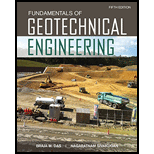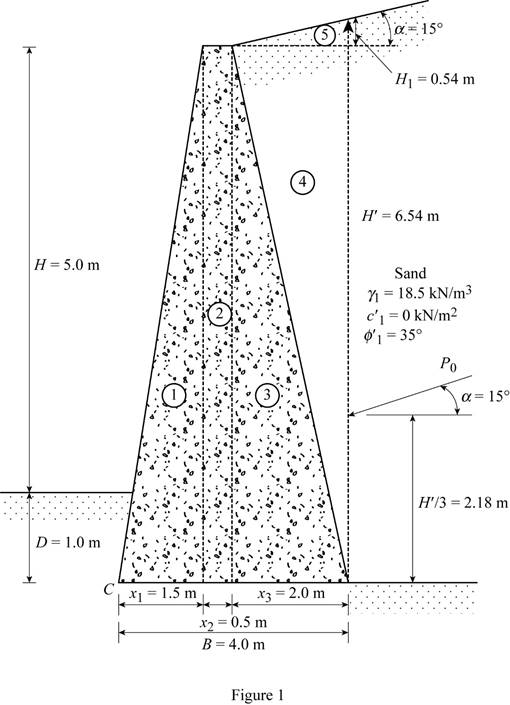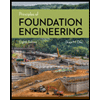
Find the factors of safety with respect to overturning, sliding, and bearing capacity failure.
Answer to Problem 15.2P
The factor of safety with respect to overturning is
The factor of safety with respect to sliding is
The factor of safety with respect to bearing capacity failure is
Explanation of Solution
Given information:
The cohesion
The unit weight
The friction angle
The unit weight
The backfill angle
Calculation:
Check stability with respect to overturning.
Consider point C as the left end of the toe base as named as C.
Divide the retaining wall into section as in Figure 1.
Sketch the section of the retaining wall as shown in Figure 1.

Here,
Refer Table 14.2, “Values of
Take the value of active earth pressure coefficient
Refer Figure 1.
Find the height of the inclined portion of backfill
Substitute 2 m for
Find the total height of the inclined backfill
Here, H is the height of retaining wall and D is the depth to the bottom of the base slab.
Substitute 5.0 m for H, 1.0 m for D, and 0.54 m
Find the active earth pressure
Substitute
Find the vertical component of the active earth pressure
Substitute
Find the horizontal component of the active earth pressure
Substitute
Find the weight of section 1
Here,
Substitute 1.5 m for
Find the moment arm or lever arm
Substitute 1.5 m for
Find the moment about point C
Substitute
Find the weight of section 2
Here,
Substitute 0.5 m for
Find the moment arm or lever arm
Substitute 1.5 m for
Find the moment about point C
Substitute
Find the weight of section 3
Here,
Substitute 2.0 m for
Find the moment arm or lever arm
Substitute 0.5 m for
Find the moment about point C
Substitute
Find the weight of section 4
Here,
Substitute 2.0 m for
Find the moment arm or lever arm
Substitute 2.0 m for
Find the moment about point C
Substitute
Find the weight of section 5
Substitute 2.0 m for
Find the moment arm or lever arm
Substitute 2.0 m for
Find the moment about point C
Substitute
Find the moment arm or lever arm
Substitute 0.5 m for
Find the moment about point C
Substitute
Find the total moment about the point C
Substitute
Find the total vertical load
Substitute
Summarize the values of weight, moment arm from C, and moment about C as shown in Table 1.
| Section | Weight (kN/m) | moment arm from C | moment about C |
| 1 | 108 | 1 | 108 |
| 2 | 72 | 1.75 | 126 |
| 3 | 144 | 2.67 | 384.5 |
| 4 | 111 | 3.33 | 369.6 |
| 5 | 10 | 3.33 | 33.33 |
| 4 | 121.6 | ||
Find the overturning moment
Substitute
Find the factor of safety
Substitute
Therefore, the factor of safety with respect to overturning is
Check the stability with respect to sliding.
Find the coefficient of passive earth pressure
Substitute
Find the passive earth pressure
Here,
Substitute 1 m for D,
Find the angle of friction
Substitute
Find the factor of safety against sliding
Substitute
Therefore, the factor of safety with respect to sliding is
Check the stability with bearing capacity failure.
Find the eccentricity (e) using the equation:
Substitute 4 m for B,
Check for eccentricity.
Substitute 0.116 m for e and 4 m for B.
The eccentricity is within the limit. Therefore, there is no tensile stress produced at the end of the steel section.
Find the maximum pressure
Substitute
Find the effective breadth
Substitute 4 m for B and 0.116 m for e.
Refer Table 16.2, “Bearing Capacity Factors” in the textbook.
Take the value of bearing capacity factor,
Take the value of bearing capacity factor,
Take the value of bearing capacity factor,
Find the load (q) due the soil in front of heel using the equation:
Substitute 1.0 m for D and
Find the inclination angle of vertical load
Substitute
Find the inclination factor
Substitute
Find the depth factor
Here,
Substitute
The depth factor
Find the inclination factor
Substitute
Find the ultimate bearing capacity of the shallow foundation
Substitute
Find the factor of safety against bearing capacity failure
Substitute
Therefore, the factor of safety with respect to bearing capacity failure is
Want to see more full solutions like this?
Chapter 15 Solutions
Fundamentals of Geotechnical Engineering (MindTap Course List)
- Determine the factor of safety against bottom heave for the braced cut described in Problem 15.18. Use Eqs. (15.66) and (15.70). For Eq. (15.70), assume the length of the cut, L = 18 m. 15.18 Refer to Figure 15.51 in which = 17.5 kN/m3, c = 60 kN/m2, and center-to-center spacing of struts is 5 m. Draw the earth pressure envelope and determine the strut loads at levels A, B, and C. FIG. 15.51arrow_forwardA vertical retaining wall 6 m. high retains a soil having the following properties. Unit weight of cohesionless soil = 19.2 kN/m3, angle of internal friction = 30°. The ground surface behind the wall is inclined at a slope of 3 horizontal and 1 vertical and the wall has moved sufficiently to developthe active condition.• Compute the Rankine’s coefficient of active earth pressure.• Compute the normal force acting on the back of the wall using Rankine’s theory.• Compute the vertical component of the force acting on the back of the wall using Rankine’s Theory.arrow_forwardA vertical retaining wall 6 m high is supporting a horizontal backfill having a weight of 16.5 kN/m3 and a saturated unit weight of 19kN/m3. Angle of internal friction of backfill is 30°. Ground water table is located 3m below the ground surface. Determine the at rest lateral earth force per meter length.Determine the location of the resultant force.Determine the at rest lateral earth force per meter length if it carries a surcharge of 50 KPa. INCLUDE FBD.arrow_forward
- The cross section of a proposed concrete retaining wall is shown in Figure 4. The unit weight of the concrete being 24kN/m3. The soil carries a uniformly distributed load of 40kN/m2 at the top. Given c=0, f=32°, gsoil=17.5kN/m3 and µ=0.5. From the data: Check the stability of the retaining wall against sliding and overturning Determine the maximum and minimum pressure under the retaining wall.arrow_forwardThe section of masonry dam is shown in Fig. U. If the uplift pressure variesuniformly from full hydrostatic at the heel to full hydrostatic at the toe, but acts only 2/3 of the area of the base, find: (a) the location of the resultant, (b) factor safety against overturning, (c) factor of safety against sliding if the coefficient of friction between base and foundation is 0.60.arrow_forwardA smooth unyielding wall retains a normally consolidated clay with no lateral movement of soil, that is at rest condition is assumed. a) Compute the coefficient of earth pressure at rest if the clay has a plasticity index of 7.8%. (Answer: 0.455) b) Compute the location of the resultant force. (Answer: 19.81 kN) c) Compute the total lateral force acting on the wall. (Answer: 1.20)arrow_forward
- Problem: The cantilever retaining wall shown in the figure resists active lateral earth pressure throughout its length. 1. Calculate the total lateral force on the wall due to active pressure in KN2. Determine the overturning moment due to lateral earth pressure in KN-m.3. Determine the resisting overturning moment in KN-marrow_forwardA retaining wall 7 m high, with its back face smooth and vertical. It retains sand with its surface horizontal. Using Rankine’s theory, determine the active earth pressure at the base when the backfill is submerged with water table at the surface. Take γ=18 kN/m^3 ,ϕ=30°, γ_sat=21 kN/m^3.arrow_forwardA retaining wall 7 m high, with its back face smooth and vertical. It retains sand with its surface horizontal. Using Rankine’s theory, determine the active earth pressure at the base when the backfill is saturated. Take γ=18 kN/m^3 ,ϕ=30°, γ_sat=21 kN/m^3.arrow_forward
- The elevation and plan of a bracing system for an open cut in sand are shown in Figure 14.21. Using Pecks empirical pressure diagrams, determine the design strut loads. Given: sand = 18 kN/m3, ' = 38, x = 3 m, z = 1.25 m, and s = 3 m.arrow_forwardA retaining wall 6 m high is supporting a horizontal backfill of soil having a void ratio of 0.5 and specific gravity of 2.7. The angle of internal friction is 32°.Compute the rankine active force on the wall if there is no water.Compute the rankine active force on the wall if the water table is on top of the horizontal backfill level.Compute the rankine active force on the wall if the water table is at the bottom of the wall and the water content is 10%.arrow_forwardA retaining wall supports a horizontal backfill that is composed of two types of soil. The first layer is 4.47m high. It has a unit weight of 16.92kN/m3. The second layer is 5.76m and has a unit weight of18.51 kn/m3. If the angle of friction for both layers is 38 degrees, determine the total active force (kN) acting on the retaining wall per unit. Use stored value. Asnwer on 5 decimal places.arrow_forward
 Fundamentals of Geotechnical Engineering (MindTap...Civil EngineeringISBN:9781305635180Author:Braja M. Das, Nagaratnam SivakuganPublisher:Cengage Learning
Fundamentals of Geotechnical Engineering (MindTap...Civil EngineeringISBN:9781305635180Author:Braja M. Das, Nagaratnam SivakuganPublisher:Cengage Learning Principles of Foundation Engineering (MindTap Cou...Civil EngineeringISBN:9781337705028Author:Braja M. Das, Nagaratnam SivakuganPublisher:Cengage Learning
Principles of Foundation Engineering (MindTap Cou...Civil EngineeringISBN:9781337705028Author:Braja M. Das, Nagaratnam SivakuganPublisher:Cengage Learning Principles of Geotechnical Engineering (MindTap C...Civil EngineeringISBN:9781305970939Author:Braja M. Das, Khaled SobhanPublisher:Cengage Learning
Principles of Geotechnical Engineering (MindTap C...Civil EngineeringISBN:9781305970939Author:Braja M. Das, Khaled SobhanPublisher:Cengage Learning Principles of Foundation Engineering (MindTap Cou...Civil EngineeringISBN:9781305081550Author:Braja M. DasPublisher:Cengage Learning
Principles of Foundation Engineering (MindTap Cou...Civil EngineeringISBN:9781305081550Author:Braja M. DasPublisher:Cengage Learning



